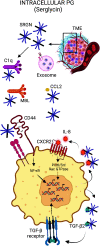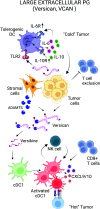Matrix proteoglycans in tumor inflammation and immunity
- PMID: 35876288
- PMCID: PMC9448345
- DOI: 10.1152/ajpcell.00023.2022
Matrix proteoglycans in tumor inflammation and immunity
Abstract
Cancer immunoediting progresses through elimination, equilibrium, and escape. Each of these phases is characterized by breaching, remodeling, and rebuilding tissue planes and structural barriers that engage extracellular matrix (ECM) components, in particular matrix proteoglycans. Some of the signals emanating from matrix proteoglycan remodeling are readily co-opted by the growing tumor to sustain an environment of tumor-promoting and immune-suppressive inflammation. Yet other matrix-derived cues can be viewed as part of a homeostatic response by the host, aiming to eliminate the tumor and restore tissue integrity. These latter signals may be harnessed for therapeutic purposes to tip the polarity of the tumor immune milieu toward anticancer immunity. In this review, we attempt to showcase the importance and complexity of matrix proteoglycan signaling in both cancer-restraining and cancer-promoting inflammation. We propose that the era of matrix diagnostics and therapeutics for cancer is fast approaching the clinic.
Keywords: dendritic; immunotherapy; matrix; proteoglycans; versican.
Conflict of interest statement
F.A. is listed as inventor on US patent US20170258898A1: “Versikine for inducing or potentiating an immune response.” None of the other authors has any conflicts of interest, financial or otherwise, to disclose.
Figures






Similar articles
-
Versican and Versican-matrikines in Cancer Progression, Inflammation, and Immunity.J Histochem Cytochem. 2020 Dec;68(12):871-885. doi: 10.1369/0022155420937098. Epub 2020 Jul 6. J Histochem Cytochem. 2020. PMID: 32623942 Free PMC article. Review.
-
Proteoglycans remodeling in cancer: Underlying molecular mechanisms.Matrix Biol. 2019 Jan;75-76:220-259. doi: 10.1016/j.matbio.2017.10.008. Epub 2017 Nov 8. Matrix Biol. 2019. PMID: 29128506 Review.
-
Versican in the Tumor Microenvironment.Adv Exp Med Biol. 2020;1272:55-72. doi: 10.1007/978-3-030-48457-6_4. Adv Exp Med Biol. 2020. PMID: 32845502 Review.
-
Role of cell surface proteoglycans in cancer immunotherapy.Semin Cancer Biol. 2020 May;62:48-67. doi: 10.1016/j.semcancer.2019.07.012. Epub 2019 Jul 20. Semin Cancer Biol. 2020. PMID: 31336150 Review.
-
Proteoglycans and Immunobiology of Cancer-Therapeutic Implications.Front Immunol. 2019 Apr 24;10:875. doi: 10.3389/fimmu.2019.00875. eCollection 2019. Front Immunol. 2019. PMID: 31068944 Free PMC article. Review.
Cited by
-
Proteoglycans: a common portal for SARS-CoV-2 and extracellular vesicle uptake.Am J Physiol Cell Physiol. 2023 Jan 1;324(1):C76-C84. doi: 10.1152/ajpcell.00453.2022. Epub 2022 Dec 2. Am J Physiol Cell Physiol. 2023. PMID: 36458979 Free PMC article. Review.
-
Screening and identification of versican as a sensitive biomarker and potential therapeutic target in basal cell carcinoma.Int J Med Sci. 2025 Apr 28;22(10):2488-2501. doi: 10.7150/ijms.105650. eCollection 2025. Int J Med Sci. 2025. PMID: 40386063 Free PMC article.
-
Revealing a novel Decorin-expressing tumor stromal subset in hepatocellular carcinoma via integrative analysis single-cell RNA sequencing.Cancer Cell Int. 2025 May 26;25(1):194. doi: 10.1186/s12935-025-03811-0. Cancer Cell Int. 2025. PMID: 40420150 Free PMC article.
-
Regulation of tumor immunity and immunotherapy by the tumor collagen extracellular matrix.Front Immunol. 2023 Aug 17;14:1199513. doi: 10.3389/fimmu.2023.1199513. eCollection 2023. Front Immunol. 2023. PMID: 37662958 Free PMC article. Review.
-
Bone marrow inflammation in haematological malignancies.Nat Rev Immunol. 2024 Aug;24(8):543-558. doi: 10.1038/s41577-024-01003-x. Epub 2024 Mar 15. Nat Rev Immunol. 2024. PMID: 38491073 Review.
References
Publication types
MeSH terms
Substances
Grants and funding
LinkOut - more resources
Full Text Sources
Medical

